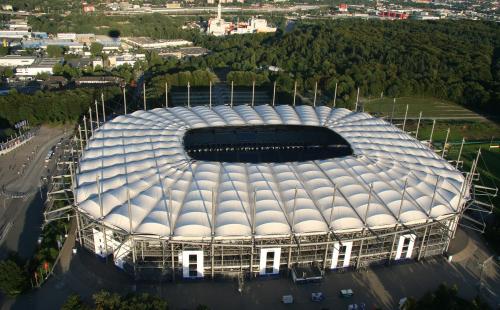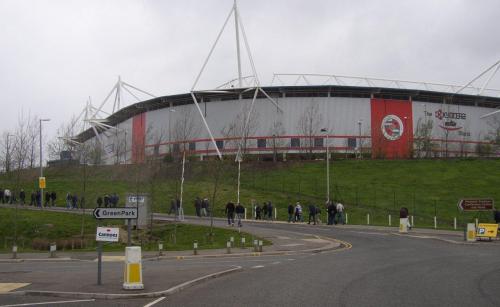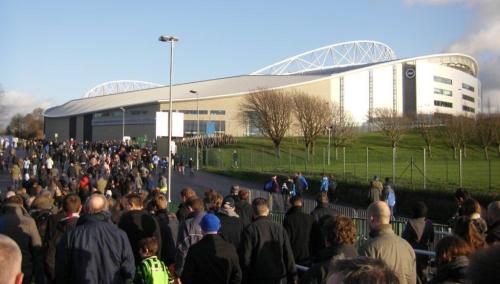
Every weekend, hundreds of thousands of football fans all over the world make the biweekly journey from home to the stadium. For many of them, this has become part of an almost sacred ritual, but quite a few will some day be faced with a change of routine when their club decides to build a new stadium.
In many cases this does not mean more than getting off one bus stop later, but not all are that fortunate, and an extreme case got recently highlighted when AFC Wimbledon and MK Dons were matched in an FA Cup round draw.
In short, the management of the old Wimbledon FC accepted an offer to move away from their home in the south of London to a new stadium in the city of Milton Keynes, 60 miles away north of London. Wimbledon fans, obviously not pleased, started a new club named AFC Wimbledon, and the old Wimbledon FC got later rebranded MK Dons.
While we do not want to delve into this case in particular, this has been done enough in the past few weeks, it does provide us with the opportunity to further investigate how far clubs typically move when they get themselves a new stadium. None will be as outlandish as the Wimbledon move, but neither have all been as easy as, for example, the move of Arsenal from Highbury to the nearby Emirates Stadium.
The whole Wimbledon farce, of course, originated out of the inability of the club to find a site for a new stadium. Redeveloping their traditional home Plough Lane led to resistance of local residents, they moved away to share Selhurst Park with Crystal Palace, but similar problems arose with other potential sites.
This is a common situation for many clubs that fancy a new or modernised stadium, though some clubs are more fortunate than others. Manchester United’s Old Trafford, for example, was built in a predominantly industrial area and its expansion therefore faced relatively little resistance. In contrast, Liverpool’s Anfield Road is tightly hemmed in by housing and expansion therefore raised (and still raises) many more complications.
In that sense, German cities may have had more foresight when they built a new generation of stadiums in the 1920s and 1930s. These stadiums often got built as part of a large complex consisting of other sports facilities and parks, and therefore had little local residents in the immediate vicinity that opposed the works when German clubs started to get rebuilding in the last decade.
For example, Schalke’s VELTINS-Arena, Cologne’s RheinEnergieStadion, Hamburg’s Imtech Arena, and Frankfurt’s Commerzbank-Arena all got built at or near the site of where their old stadium used to stand.

Clubs in countries such as England, Spain, and Holland often did not find themselves that lucky as stadiums were built in denser urban areas, and in hindsight it is actually quite surprising that so many English clubs were able to rebuilt often significant parts of their stadiums without much difficulty in the early 1990s. Stamford Bridge, Boleyn Ground, and St James’ Park are examples that got extensively redeveloped while being surrounded by residential housing.
English clubs that had no option of rebuilding had one advantage though, which was that the de-industrialisation of England meant that there was often a derelict industrial site available at a rather central location not too far from their original ground. Sunderland, Middlesbrough, Southampton, Wigan, and Derby, for example, all found sites relatively close to the city centre. Not always the prettiest locations, but at least easy to reach.
Other clubs weren’t that lucky, and saw themselves pushed to the edge of the city as a result of the not-in-my-backyard attitude of the local populace. Sometimes with reason, though in other cases the fear of increased traffic every other Saturday was enough to start petitions and lobby the local political parties.
Mind that a location outside the city is neither always as easy to find as it seems, because there is usually some green that gets sacrificed, which causes local environmental groups to get up in arms (ask Bristol City). Still, the combination of a new stadium with an office and retail park somewhere along the motorway was often the easiest solution, with notable English examples being Reading, Coventry City, Brighton & Hove Albion, Stoke City, and Bolton Wanderers.

In the case of Stoke City and the Britannia Stadium this still meant a relatively central location, but Bolton fans are now faced with a significant trip out of town to get to the Reebok Stadium.
Building a new stadium on an office and retail park has also been the preferred strategy in the Netherlands, with some prime examples being Twente’s Grolsch Veste, AZ Alkmaar’s AFAS Stadion, NAC Breda’s Rat Verlegh Stadion, and ADO Den Haag’s Kyocera Stadion.
Bayern is one of the few German clubs to have taken this route, as did Borussia Mönchengladbach and FSV Mainz. The site of the dug in Bökelbergstadion was, for example, not very suitable for a new stadium, whereas the old Olympiastadion in Munich did not get demolished.
While sufficient space surrounded the old large Portuguese stadiums so that newer versions could get built alongside, the likes of Espanyol and Real Murcia in neighbouring Spain were not that lucky and moved toward the edge of the city. This also raises the question whether the locations of Estadi Cornellà-El Prat and Estadio Nueva Condomina are perhaps responsible for the disappointing attendances of these clubs.
Overall, the result is that quite a few clubs find themselves at a ground far away from where they initially made history. The Allianz Arena is 10 kilometres away from the Olympiastadion (and even further from the Grünwalder Stadion), the Reebok Stadium 5.5 mile from the old Burnden Park, the Grolsch Veste 6 kilometres from the old Diekmanstadion, and Galatasaray’s new Türk Telekom Arena 6 kilometres from the Ali Sami Yen.
While few fans will get very excited about a move to an out-of-town retail park, most are often happy enough to move into a new stadium, especially if this has come as the result of a long and painful process. After all, there are probably few Brighton fans that will complain that the brand new The Amex is a few miles out of town. On the other hand, few Everton fans got excited when the club proposed a move to the town of Kirkby, because they still had a pretty decent home in Goodison Park.

Things tend to get more sensitive in large cities with multiple clubs attached to certain geographical areas. Had fans of Wimbledon been happy with a move to, for example, East-London Stratford? While they likely wouldn’t have formed a new club, they’d undoubtedly have protested against a move from southern London.
In similar fashion, various Chelsea fans were not very supportive of a move to the proposed Battersea Power Station site, only a few miles away from Stamford Bridge, but on the southern side of the river Thames. Spurs fans, in the meantime, were not exactly keen on moving to the London Olympic Stadium, which was too much east for their liking.
While Arsenal fans had it easy this time around, outrage ensued when they moved from the south-east to northern Highbury in 1913. Atlético de Madrid fans also heavily protested when the club moved from the north of the city south to Estadio Vicente Calderón. Ironically, fans now again object to a move back to the north(-east).
If there is any other place in the world where clubs are as much attached to their neighbourhood as in London, than it must be Buenos Aires. That’s obviously no surprise once you realise that the greater Buenos Aires area counts 12 top-flight teams at the moment. That this get very particular is highlighted by San Lorenzo, who were forced to move two kilometres south from their old home in the Boedo area to the Nueva Pompeya area, but still long to return to their previous home.
This has never been much of an issue in Italy as Italian clubs are used to sharing a stadium and club identity is therefore not much based on geography. Roma, for example, is investigating possible stadium sites all over the city, and Inter is likely to replace the western San Siro with a new stadium in the south-east of the city over 12 kilometres away from their present home.
For the few fans that have followed Wimbledon north, there may be some solace in the fact that it could have been worse (yes, really). In the USA, for example, you are never assured that your team will stay in your city as the franchise owner may just decide otherwise. San Jose Earthquakes fans suddenly found themselves without a team when the owner decided to move the club to Houston, which is 3,000 kilometres away. Fortunately for them, a replacement Earthquakes returned after two years.
But before we snigger “that only happens in the US”, mind that two clubs recently left Mexico City to find a larger fanbase elsewhere. Tough luck for the local fans of Atlante and Necaxa, who now have to make bi-weekly 500 and 1,500-kilometre trips to Aguascalientes and Cancun.
In the end, whether you can keep taking the same bus or metro to the match after a stadium move is hardly ever in your hands, and if it therefore happens, count yourself lucky. But if it doesn’t, remember that at some point in time there will be a next generation that decries a move away from their cherished home, indeed, that soulless generic concrete building on that office and retail park.
Photo credits: Reebok Stadium by Geograph user Gary Rodgers, Imtech Arena by Reinhard Kraasch, Madejski Stadium and The Amex by Stephan Hoogerwaard.